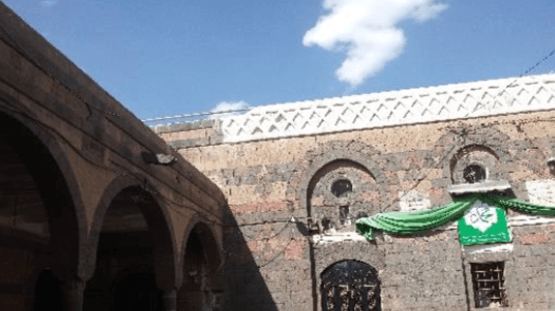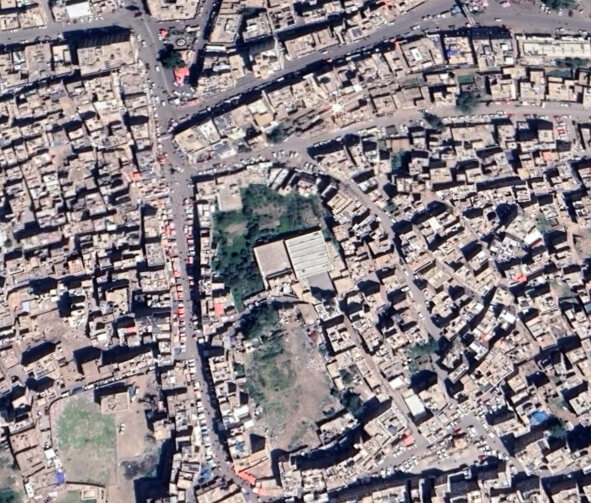
Khuḍayr Mosque – Old Ṣan‘ā’
مسجد خضير-صنعاء القديم ة
Monument description
Khudayr Mosque is located in the Khudayr Quarter, which was named after the Mosque built by Manee’ bin Majid Abu Matar Al-Hamdani Al-Madari Al-Sana’ani. Three mosques were built in Sana‘a, including a mosque that was in Al-Baida called Al-Akhdar Mosque, that it is in ruins and no longer exists.

Architectural and cultural value
Construction style and built date: The layout of the Mosque is in the style of mosques, which consist of a Prayer Hall with a flat roof sustained by wooden beams resting directly on the capitals of stone columns and arches. The monument was built in the year 1350 AH.
Components of the Mosque: The Khudayr Mosque is divided into 2 main parts which are the Prayer Hall and two southern and western courtyards, in addition to some accessories such as: Al-Mataher, modern bathrooms, a chapel belonging to Al-Matahir, the residence of Al-Qayyim, the women’s chapel, a mausoleum, a pond )Berkah) and stores.
- Justifications for intervention:
- 1 – Neglecting the competent authorities in carrying out periodic restoration work due to the lack of budgets for the repairs.
2 – Preserving the monument from disappearance and stopping the damage caused to the monument from expanding.
3 – Restoration of the damage to the mosque resulting from the flight strikes of the southern part of the old city of Sana’a.
4 – Contribute to the restoration of damaged monuments in a proper manner in order to keep Old Sana’a on the World Heritage Register.
- Monument conditions:
- Damages resulting from the old building or building and time factors, damages resulting from wrong repairs, damages resulting from previous poor restoration, and damages resulting from water leakage into the mosque, and these damages include.
1 – Existence and cracking of a substance, Qadad in the water pool and walls and surfaces.
2 – Moisture and corrosion of stones due to leakage of waste water.
3 – Cracks on the roof of the prayer house.
4 – The problem of simple subsidence, moisture and salinity in the foundations.
5 – Moisture and erosion of yoghurt and bonding mortar due to rain water leakage.
6 – The presence of unconventional elements distorting the general landscape and historical value
- Treatment:
- – Restoration and re-layer Alqodd in the affected places.Re-dressing and making a coast to drain rainwater on the northern facade.
– Reconstruct the dilapidated walls.
– stop longitudinal cracks
– Treating damaged foundations and solving the problem of moisture.
– Treating roofs and preventing rainwater intrusion.
– Removing unconventional elements that distort the general landscape and historical value.

Countries









